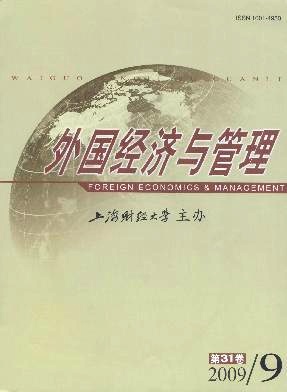交易专用性投资效应及治理机制研究评介
外国经济与管理 2009 年 第 31 卷第 09 期, 页码:18 - 28
摘要
参考文献
摘要
本文在文献梳理的基础上首先分析了交易专用性投资的负面效应和正面效应;然后总结了四种治理机制,阐述了每种治理机制的定义、作用机理和具体方式,并介绍了某些治理机制的适用情境及其相互关系等方面的研究成果;最后指出了有待深入研究的四个方面。
[1]Williamson,O E.Comparative economic organization:The analysis of discrete structural alternatives[J].Administrative ScienceQuarterly,1991,36(2):269-296.
[2]Dyer,J H,and Singh,H.The relational view:Cooperative strategy and sources of interorganizational competitive advantage[J].A-cademy of Management Review,1998,23(4):660-679.
[3]Williamson,O E.Markets and hierarchies:Analysis and antitrust implication[M].New York:The Free Press,1975.
[4]Williamson,O E.The economic institutions of capitalism[M].New York:Free Press,1985.
[5]Klein,B,Crawford,R A,and Alchian,A A.Vertical integration,appropriable rents,and the competitive contracting process[J].Journal of Law and Economics,1978,21(Oct.):297-326.
[6]Artz,K W,and Brush,T H.Asset specificity,uncertainty and relational norms:An examination of coordination costs in collabora-tive strategic alliances[J].Journal of Economic Behavior and Organization,2000,41(3):337-362.
[7]Hwang,P.Asset specificity and the fear of exploitation[J].Journal of Economic Behavior and Organization,2006,60(4):423-438.
[8]Jap,S D,and Ganesan,S.Control mechanisms and the relationship life cycle:Implications for safeguarding specific investments anddeveloping commitments[J].Journal of Marketing Research,2000,37(2):227-245.
[9]Williamson,O E.Credible commitments:Using hostages to support exchange[J].American Economic Review,1983,73(4):519-535.
[10]Zajac,E J,and Olsen,C P.From transaction cost to transaction value analysis:Implications for the study of interorganizationalstrategies[J].Journal of Management Studies,1993,30(1):131-145.
[11]Dyer,J H.Specialized supplier networks as a source of competitive advantage:Evidence from the auto industry[J].Strategic Ma-nagement Journal,1996a,17(4):271-292.
[12]Dyer,J H.Does governance matter?Keiretsu alliances and asset specificity as a source of Japanese competitive advantage[J].Or-ganization Science,1996b,7(6):649-666.
[13]Dyer,J H.Effective interfirm collaboration:How firms minimize transaction costs and maximize transaction value[J].StrategicManagement Journal,1997,18(7):535-556.
[14]Subramani,M R,and Venkatraman,N.Safeguarding investments in asymmetric interorganizational relationships:Theory and evi-dence[J].Academy of Management Journal,2003,46(1):46-62.
[15]Claro,D P,Claro,P B O,and Hagelaar,G.Coordinating collaborative joint efforts with suppliers:The effects of trust,transactionspecific investments and information network in the Dutch flower industry[J].Supply Chain Management:An international Journal,2006,11(3):216-224.
[16]Wathne,K H,and Heide,J B.Opportunism in interfirm relationships:Forms,outcomes,and solutions[J].Journal of Marketing,2000,64(Oct.):36-51.
[17]Heide,J B,Wathne,K H,and Rokkan,A I.Interfirm monitoring,social contracts,and relationship outcomes[J].Journal of Mar-keting Research,2007,64(Aug.):425-433.
[18]Vazquez,R,Iglesias,R,and Bosque,I R.The efficacy of alternative mechanisms in safeguarding specific investments from oppor-tunism[J].Journal of Business&Industrial Marketing,2007,22(7):498-507.
[19]Hill,Charles W L.Cooperation,opportunism,and the invisible hand:Implications for transaction cost theory[J].Academy ofManagement Review,1990,15(Jul.):500-513.
[20]Lado,A A,Dant,R R,and Tekleab,A G.Trust-opportunism paradox,relationalism,and performance in interfirm relationships:Evidence from the retail industry[J].Strategic Management Journal,2008,29(4):401-423.
[2]Dyer,J H,and Singh,H.The relational view:Cooperative strategy and sources of interorganizational competitive advantage[J].A-cademy of Management Review,1998,23(4):660-679.
[3]Williamson,O E.Markets and hierarchies:Analysis and antitrust implication[M].New York:The Free Press,1975.
[4]Williamson,O E.The economic institutions of capitalism[M].New York:Free Press,1985.
[5]Klein,B,Crawford,R A,and Alchian,A A.Vertical integration,appropriable rents,and the competitive contracting process[J].Journal of Law and Economics,1978,21(Oct.):297-326.
[6]Artz,K W,and Brush,T H.Asset specificity,uncertainty and relational norms:An examination of coordination costs in collabora-tive strategic alliances[J].Journal of Economic Behavior and Organization,2000,41(3):337-362.
[7]Hwang,P.Asset specificity and the fear of exploitation[J].Journal of Economic Behavior and Organization,2006,60(4):423-438.
[8]Jap,S D,and Ganesan,S.Control mechanisms and the relationship life cycle:Implications for safeguarding specific investments anddeveloping commitments[J].Journal of Marketing Research,2000,37(2):227-245.
[9]Williamson,O E.Credible commitments:Using hostages to support exchange[J].American Economic Review,1983,73(4):519-535.
[10]Zajac,E J,and Olsen,C P.From transaction cost to transaction value analysis:Implications for the study of interorganizationalstrategies[J].Journal of Management Studies,1993,30(1):131-145.
[11]Dyer,J H.Specialized supplier networks as a source of competitive advantage:Evidence from the auto industry[J].Strategic Ma-nagement Journal,1996a,17(4):271-292.
[12]Dyer,J H.Does governance matter?Keiretsu alliances and asset specificity as a source of Japanese competitive advantage[J].Or-ganization Science,1996b,7(6):649-666.
[13]Dyer,J H.Effective interfirm collaboration:How firms minimize transaction costs and maximize transaction value[J].StrategicManagement Journal,1997,18(7):535-556.
[14]Subramani,M R,and Venkatraman,N.Safeguarding investments in asymmetric interorganizational relationships:Theory and evi-dence[J].Academy of Management Journal,2003,46(1):46-62.
[15]Claro,D P,Claro,P B O,and Hagelaar,G.Coordinating collaborative joint efforts with suppliers:The effects of trust,transactionspecific investments and information network in the Dutch flower industry[J].Supply Chain Management:An international Journal,2006,11(3):216-224.
[16]Wathne,K H,and Heide,J B.Opportunism in interfirm relationships:Forms,outcomes,and solutions[J].Journal of Marketing,2000,64(Oct.):36-51.
[17]Heide,J B,Wathne,K H,and Rokkan,A I.Interfirm monitoring,social contracts,and relationship outcomes[J].Journal of Mar-keting Research,2007,64(Aug.):425-433.
[18]Vazquez,R,Iglesias,R,and Bosque,I R.The efficacy of alternative mechanisms in safeguarding specific investments from oppor-tunism[J].Journal of Business&Industrial Marketing,2007,22(7):498-507.
[19]Hill,Charles W L.Cooperation,opportunism,and the invisible hand:Implications for transaction cost theory[J].Academy ofManagement Review,1990,15(Jul.):500-513.
[20]Lado,A A,Dant,R R,and Tekleab,A G.Trust-opportunism paradox,relationalism,and performance in interfirm relationships:Evidence from the retail industry[J].Strategic Management Journal,2008,29(4):401-423.
引用本文
周俊, 薛求知. 交易专用性投资效应及治理机制研究评介[J]. 外国经济与管理, 2009, 31(9): 18–28.
导出参考文献,格式为:
下一篇:企业环境战略研究前沿探析





 6875
6875  621
621

